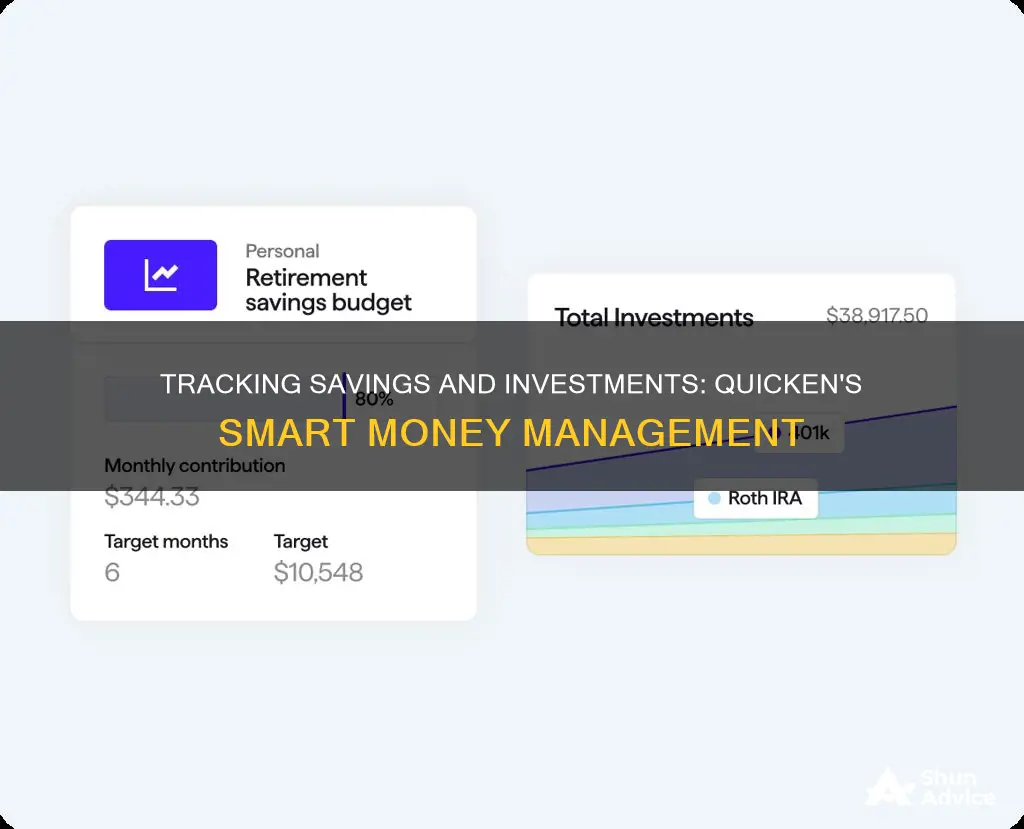
Quicken is a personal finance and money management software that allows you to track your savings and investments. It offers a range of features, including the ability to connect all your financial accounts, see what's left in your monthly budget, and customise your financial views. With Quicken, you can monitor your investments on the go by syncing with their mobile and web companion apps. You can also monitor all your investment accounts, from brokerages to retirement plans, in one place. Additionally, Quicken allows you to track your savings goals by hiding funds in an account, helping you save money by making you think twice about spending.
| Characteristics | Values |
|---|---|
| Number of accounts | 14,000+ |
| Account types | Spending, savings, loans, investments, retirement |
| Customizability | Edit and filter all your financial reports |
| Investment accounts | Brokerage, 401(k)s, IRAs, options, bonds, ETFs, mutual funds |
| Investment tracking | Automatic and manual |
| Security | 256-bit encryption |
What You'll Learn

Syncing Quicken with mobile and web apps
To sync your Quicken data to your mobile device, you will need to set up Quicken Mobile Sync in Quicken Desktop.
For Windows:
- Open Quicken and go to the Mobile & Web tab. Depending on the sizing of the Quicken window, the Mobile & Web tab may be located in the More tab.
- Click "Get Started" to select the accounts you want to sync to your mobile device.
- Place a check next to each account you want to sync to your mobile device.
- After selecting the accounts, type your bank password(s) in the field(s) above the accounts and click "Done". Then, click "Done" again on the Accounts Synced dialog.
- To sync your Quicken data to Quicken Mobile, click "Sync Now" under the Mobile & Web tab.
- Go to your mobile app and sign in with your Quicken ID.
- Swipe down on the Mobile App home screen. All the data from the cloud will then be downloaded to your mobile device.
For Mac:
- Open Quicken for Mac.
- Go to Quicken > Settings.
- Sign in with your Quicken ID, if prompted.
- Under Mobile, Web & Alerts, use the Sync toggle switch to turn on Mobile access.
- Go to the Accounts menu > Sync to Mobile or click the circular arrow above your account list to Update Online Accounts.
- Go to your mobile app and sign in with your Quicken ID.
- Swipe down on the Mobile App home screen. All the data from the cloud is then downloaded to your mobile device.
Using the Quicken Web App:
- On your web browser, open app.quicken.com.
- Sign in with the Quicken ID that you used to sync your data file from the desktop.
- You can download transactions from your financial institution directly to Quicken Web for banking accounts. Investment accounts will need to be downloaded to your desktop and synced to the web.
- You can sync more than one data file to your web application using the same Quicken ID. To see all of the Quicken files associated with your Quicken ID, in Quicken desktop, click Edit > Preferences > Cloud Accounts and click Cloud accounts associated with this Quicken ID.
Using the Quicken Mobile Companion App:
- From the iTunes or Android app stores, download the Quicken app for free.
- Sign in with your Quicken ID to get started.
- Select the Checking, Savings, Investments, Credit, or Cash accounts you’d like to see on your Quicken Mobile app and click "Done".
- Click the Update Accounts icon to download new transactions and sync data to your mobile device. Make sure that Sync to Quicken Cloud is selected.
- Go to the Mobile & Alerts tab and click Sync Now in the upper right corner to sync with the Quicken Mobile app.
Maximizing Savings: Strategies to Double Your Money
You may want to see also

Tracking investments in Quicken Simplifi
To add your investment accounts, hover over the panel on the left-hand side and select 'Investments'. This will bring up the Portfolio page, which will display your Total Market Value, Today's Change, and Total Gain, along with a list of your holdings and their current values. If you wish to view a specific account, simply click on the 'All Accounts' drop-down menu in the upper left, uncheck any accounts you want to remove, and then click 'Apply'.
For more detailed information on a particular holding, simply click on it. This will bring up more details, market stats, and a breakdown by account. You can also access the Investments Portfolio for a specific investment account by selecting the account from the Accounts List.
If you prefer to track your investments manually, you can add holdings or cash to a Manual Investment Account. To do this, hover over the panel on the left-hand side and select 'Investments'. Then, click the blue '+ Holding' button and select the account you want to add the holding to. Make sure the 'Stocks or options' tab is selected, and enter the company name, shares quantity, and price per share. You can also enter the total cost to track gains. If you select a valid ticker symbol when entering the company name, the price per share will be automatically entered at the latest quote price.
You can also add cash to a Manual Investment Account. Follow the same steps as above, but select the 'Cash' tab and enter the total cash amount.
To edit or delete manually created holdings or cash, hover over the panel on the left-hand side, select 'Investments', locate the holding or cash you want to edit or delete, and click on the three dots at the end. From there, you can make the necessary changes or delete the holding or cash.
Additionally, Quicken Simplifi offers an Investments News Feed, which provides news related to your current holdings. You can customize the news feed by selecting a specific investment account or viewing it for your entire portfolio.
By utilizing these features, you can effectively track your investments in Quicken Simplifi, giving you a comprehensive view of your portfolio and helping you make informed financial decisions.
Savings and Investments: Strategies for Effective Money Allocation
You may want to see also

Setting up savings goals
Step 1: Access the Savings Goals Window
To begin, open the Savings Goals window by navigating to Planning > Savings Goals. If you don't see the Planning tab, go to the Quicken menu and select View > Tabs To Show > Planning. Click on the Get Started button or, if it's not visible, click on Goal Actions and select New Savings Goal from the drop-down list.
Step 2: Create a New Savings Goal
In the Create New Savings Goal dialog, enter a name for your goal, the target amount you want to save, and the date by which you aim to achieve this goal. The finish date should be set before any significant events or milestones you're saving for, such as a trip or a special occasion.
Step 3: Contribute to Your Savings Goal
To add funds to your savings goal, select the Contribute icon (a white cross in a small green circle) to open the Contribute To Goal dialog. Choose the account from which you want to transfer funds using the From Account drop-down list. Enter the amount you wish to transfer in the Amount box. Quicken will suggest a projected monthly contribution, but you can customise this as needed.
Step 4: Automate Your Contributions
You can automate your savings by creating a scheduled transaction to transfer money periodically from your bank account to your savings goal. This helps in building your savings effortlessly over time.
Step 5: Withdrawing Funds
Once you've achieved your savings goal, you can withdraw the funds to use as needed. Go to the Planning tab, choose Savings Goals, and select the goal you want to withdraw from. Click on the Withdraw icon (a small white minus sign in a red circle) and specify the amount and date of withdrawal. The funds will be returned to the original account.
Step 6: Editing and Deleting Savings Goals
You can edit an existing savings goal by clicking on the Planning tab, selecting Savings Goals, and then clicking on the Edit Goal gear icon. From here, you can adjust the goal amount and finish date. To delete a savings goal, right-click on its name in the Account Bar, select Edit/Delete Account, and confirm the deletion.
Additional Tips:
- Use a naming convention for your savings goals, such as starting the name with a star, to easily identify and group them together.
- Always return the funds to the same account from which they were deducted to avoid confusion in Quicken.
- Consider opening tax-free savings accounts to maximise your savings and reduce taxable interests.
Maximizing UK Savings: Investment Strategies for Beginners
You may want to see also

Tracking savings and investments manually
Tracking your savings and investments manually in Quicken is a straightforward process. Here's a step-by-step guide:
Step 1: Set Up Your Accounts
Firstly, you need to set up your investment accounts in Quicken. This involves adding your investment accounts, such as brokerage or retirement accounts, to the software. You can do this by going to the "Accounts" section and selecting "Add Account". From there, follow the prompts to enter the necessary information, such as the account type, institution, and login credentials.
Step 2: Manually Enter Holdings
If you choose to track your investments manually, you can add your holdings to your investment accounts. Go to the Investments section, select the "+ Holding" button, and choose the account you want to add the holding to. You will then be prompted to enter the company name, number of shares, and price per share. You can also add the total cost to track gains. Make sure to use a valid ticker symbol to ensure that the price per share is accurate and that your holdings update automatically.
Step 3: Monitor and Update Your Portfolio
Once you've set up your accounts and added your holdings, you can monitor your portfolio's performance. Quicken provides a comprehensive view of your investments, allowing you to track their market value, today's change, and total gain. You can also view detailed information about specific holdings, including market stats and a breakdown by account. It's important to regularly update your portfolio to reflect any changes, such as buying or selling stocks, so that you have an accurate picture of your investments.
Step 4: Customize Your Portfolio View
Quicken allows you to customize how you view your portfolio. You can group your holdings by type, brokerage, or asset class, or create your own unique groupings. This flexibility lets you track your investments in a way that makes sense for your investment strategy. For example, you can separate your blue-chip holdings from your tech stocks or view your investments for your children separately.
Step 5: Track Performance and Returns
Quicken offers tools to help you understand your investment performance and returns. You can run IRR (Internal Rate of Return) and ROI (Return on Investment) performance reports to see how your investments have performed over time. Additionally, Quicken can track investment fees, giving you a clear picture of your true market returns. This information can help you make informed decisions about buying, holding, or selling investments.
Step 6: Manual Updates for Certain Investments
Keep in mind that some investments, such as private equities and partnerships, may need to be tracked manually. Quicken allows you to add these types of investments to your portfolio, but you'll need to update their values manually as they are not publicly traded. Regularly updating the values of these investments will ensure that your portfolio remains accurate.
529 Savings Plans: Smart Investment Strategies, per Forbes
You may want to see also

Tracking investments across multiple accounts
Tracking your investments across multiple accounts can be a challenging task, but with Quicken, you can easily monitor your investments in one place. Here are some tips to help you track your investments across multiple accounts using Quicken:
Connect Your Accounts
Quicken allows you to connect all your financial accounts, including savings, investments, retirement, and more. By syncing with Quicken, you can view your accounts across various financial institutions in one convenient dashboard. This makes it easier to see your entire portfolio at a glance.
Monitor All Your Investment Accounts
Quicken enables you to monitor all your investment accounts, including brokerage, 401(k)s, IRAs, options, bonds, ETFs, and mutual funds. You can track both liquid and long-term holdings, helping you balance your short- and long-term financial goals. This comprehensive view makes it easier to understand your true risk level, allocations, and performance.
Add "Manual" Brokerage Accounts
If you hold publicly traded securities in a brokerage account that doesn't permit automatic connections, you can manually add your buy/sell transactions in Quicken. The software will then update your position and download security prices each time you refresh, ensuring you see the current value of your "manual" accounts.
Include Private Equities and Partnerships
Quicken also allows you to add investments in partnerships and private equities that aren't publicly traded. While you'll need to track these manually, it ensures that you can see your complete portfolio, including these "side" investments.
Customize Your Portfolio View
You can customize how your portfolios are grouped. Group them by type, brokerage, or asset class, or create unique "buckets" to categorize your holdings in a way that makes sense for your financial situation. This flexibility ensures you can track your investments in a way that aligns with your goals.
Understand Your Returns
Quicken provides tools to help you understand your true market returns. You can run IRR and ROI performance reports to analyze how your investments have performed over time. Additionally, Quicken can track your investment fees, giving you a clear picture of your returns and enabling fair comparisons when making investment decisions.
Plan for Tax Implications
Quicken can track your individual buy/sell transactions and lets you specify lots for those transactions. This feature helps you track the cost basis of your positions and see your realized and unrealized gains. This level of detail is valuable when it comes to tax planning and can be easily exported to tax preparation software or shared with your accountant.
By following these steps and utilizing the features offered by Quicken, you can effectively track your investments across multiple accounts, giving you greater control over your financial future.
Kroger Savings Club: A Smart Investment Strategy
You may want to see also
Frequently asked questions
You can track your savings and investments in Quicken by connecting your investment accounts so that your financial institution automatically sends in the information, or by manually tracking your stocks and holdings.
To add a manual investment account, hover over the panel on the left-hand side and select 'Investments'. Then, click the blue '+ Holding' button and select the account you'd like to add the holding to.
To add cash to a manual investment account, hover over the panel on the left-hand side and select 'Investments'. Then, click the blue '+ Holding' button and select the account you'd like to add the cash to. Select the 'Cash' tab and enter the total cash amount.
To edit or delete a manually created holding or cash entry, hover over the panel on the left-hand side and select 'Investments'. Locate the holding or cash entry you'd like to edit or delete, hover over it, and click the three dots at the end. From there, you can either click 'Edit' to make changes and then 'Update', or select 'Delete' and confirm the deletion.







